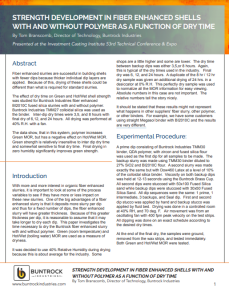Strength Development in Fiber Enhanced Shells with and Without Polymer as a Function of Dry Time
Abstract
Fiber enhanced slurries are successful in building shells with fewer dips because thicker individual dip layers are applied. Because of this, drying of these shells could be different than what is required for standard slurries.
The effect of dry time on Green and Hot/Wet shell strength was studied for Buntrock Industries fiber enhanced BI2010C fused silica slurries with and without polymer. Buntrock Industries TMM27 colloidal silica was used as the binder. Inter-dip dry times were 3,5, and 8 hours with final dry of 6,12, and 24 hours. All drying was performed at 40% R.H. with a fan.
The data show, that in this system, polymer increases Green MOR, but has a negative effect on Hot/Wet MOR. Green strength is relatively insensitive to inter dip dry time and somewhat sensitive to final dry time. Final drying in zero humidity significantly improves green strength.
Introduction
With more and more interest in organic fiber enhanced slurries, it is important to look at some of the process variables to see if they have more or less impact on these new slurries. One of the big advantages of a fiber enhanced slurry is that it deposits more slurry per dip and thus for a fixed number of dips, the fiber enhanced slurry will have greater thickness. Because of this greater thickness per dip, it is reasonable to assume that it may take longer to dry each dip. This paper investigates the time necessary to dry the Buntrock fiber enhanced slurry with and without polymer. Green (room temperature) and Hot/Wet (boiling water) MOR are used as a measure of dryness.
It was decided to use 40% Relative Humidity during drying because this is about average for the industry. Some shops are a little higher and some are lower. The dry time between backup dips was either 3,5,or 8 hours. Again, this is typical of the dry times used in the industry. Final dry was 6, 12, and 24 hours. A duplicate of the 8 hr / 12 hr dry sample was given an additional drying of 24 hrs. in a desiccator at 0% R.H. This perfectly dry sample was used to normalize all the MOR information for easy viewing. Absolute numbers in this case are not important. The relative numbers tell the story nicely
It should be stated that these results might not represent what happens in other suppliers’ fiber slurry, other polymer, or other binders. For example, we have some customers using straight Megasol binder with BI2010C and the results are very different.



